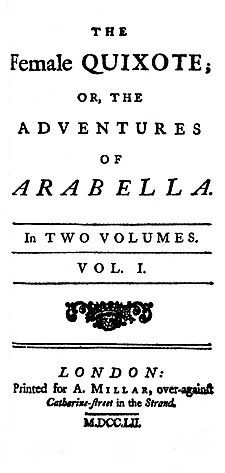
The Female Quixote; or, The Adventures of Arabella is a comedic novel by Scottish writer Charlotte Lennox imitating and parodying the ideas of Miguel de Cervantes' Don Quixote. Published in 1752, two years after she wrote her first novel, The Life of Harriot Stuart, it was her best-known and most-celebrated work. It was approved by both Henry Fielding and Samuel Richardson, applauded by Samuel Johnson, and used as a model by Jane Austen for Northanger Abbey.[1] It has been called a burlesque, "satirical harlequinade", and a depiction of the real power of females.[2] While some dismissed its protagonist Arabella as a coquette who simply used romance as a tool, Scott Paul Gordon said that she "exercises immense power without any consciousness of doing so".[3] Norma Clarke has ranked it with Clarissa, Tom Jones and Roderick Random as one of the "defining texts in the development of the novel in the eighteenth century".[4]
- ^ Doody, Margaret Anne (1989). Introduction to The Female Quixote. United States: Oxford University Press. ISBN 978-0-19-954024-2.
- ^ "Chawton House Library: Library and early women's writing – Women writers – Charlotte (Ramsay) Lennox" (PDF). chawton.org. Retrieved 30 October 2010.
- ^ Gordon, Scott Paul (Summer 1998). "The Space of Romance in Lennox's Female Quixote". SEL: Studies in English Literature 1500–1900. 38 (3). Rice University: 499–516. doi:10.2307/451060. JSTOR 451060 – via JSTOR.
- ^ Philippe Sejourne, The Mystery of Charlotte Lennox, First Novelist of Colonial America, Vol. 62 (Aix-En-Provence: Publication Des Annales De La Faculte Des Lettres, 1967).